Collecting and Preserving Evidence Following a Process Safety Event
The article provides a comprehensive guide on collecting and preserving evidence following a process safety event such as an explosion or fire. It emphasizes the importance of gathering various types of evidence including physical items, process data, witness statements, documentation, radio traffic, and more for thorough investigations.
PROCESS SAFETY
2/14/20252 min read


After a process safety event such as an explosion or fire, it's crucial to gather and preserve evidence for thorough investigations. This guide outlines steps to effectively collect various types of evidence: physical items, process data, witness statements, documentation, radio traffic, and more.
Physical Evidence:
Secure the scene to prevent tampering with evidence. Security measures may range from barricade tape to professional security services, depending upon the type and severity of the incident and other security measures already present at the site.
Photograph or videotape items before moving them.
Label each item uniquely and store it securely in a tamper-proof location using evidence bags for added protection.
Process Data:
Utiliize Process Control or Automation personnel to immediately capture data from Programmable Logic Controllers (PLCs) and Distributed Control Systems (DCSs). Use vendor resources and expertise, if necessary. Most systems have a limited storage duration that can range from hours to weeks, depending on the system.
Store captured data securely and tamper-proof, such as backing up onto encrypted storage devices or cloud services with robust security measures.
Witness Statements:
Prepare a list of potential witnesses, including operators, maintenance personnel, supervisors, and nearby employees.
Record interviews using audio or video devices to ensure accuracy and prevent misinterpretations.
Develop detailed written reports based on recorded interviews.
Documentation:
Preserve pre-incident versions of Standard Operating Procedures (SOPs), work instructions, Operations and Maintenance documentation, Work Orders, Management of Change (MOC) documents, Process Safety Information (PSI), Process Hazard Analyses (PHA), Layer of Protection Analysis (LOPA), and other relevant materials.
Collect all related documentation, even if it seems unrelated, as it may provide valuable context.
Radio Traffic:
Access or record ongoing radio communications during the incident.
Ensure proper functioning and setup of recording systems to capture all relevant channels.
Retrieve call logs and data from any central monitoring stations.
Work Orders, MOCs, PSSRs:
Review work orders for recent maintenance or repairs and corresponding Management of Change (MOC) documents detailing changes to processes or equipment, and PreStartup Safety Reviews (PSSR) documenting the post-change status.
Gather all relevant documentation related to these areas and ensure access to any historical records.
Preserving Digital Evidence:
Use secure storage methods like encrypted external drives or cloud services with proper security measures.
Maintain a chain of custody for digital evidence to ensure its integrity and admissibility in legal proceedings.
By following this comprehensive approach, investigators can thoroughly examine the factors contributing to process safety events. This enables them to identify root cause and implement measures to prevent similar incidents from happening again.
© 2025. All rights reserved.
